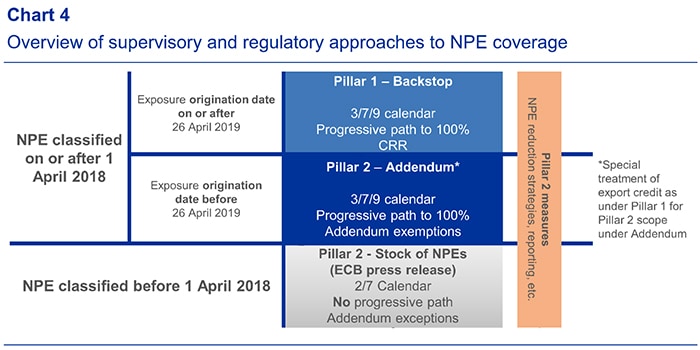Article

Provisioning for new non-performing loans
ECB revises supervisory expectations
On 22 August 2019, the ECB published a press release on revising the addendum to the ECB guidance to banks on non-performing loans Communication on supervisory coverage expectations for NPEs, the goal of which was to, at least partially, integrate the requirements of the new EU regulation on the prudential provisioning backstop into the ECB’s supervisory expectations for prudential provisioning for non-performing loans.
Due to the high proportion of NPLs (an NPL ratio of 8%) among the loans held by major banks at the start of the Single Supervisory Mechanism (SSM), the ECB paid particular attention to the treatment of NPLs. In March 2017, the ECB issued guidance on how to treat non-performing loans. A year later, supervisory expectations for prudential provisioning were added to the ECB guidance (addendum to the ECB guidance). As legislation on NPE treatment under pillar 1 was still pending from the EU at that time, the ECB announced a review of its supervisory expectations as soon as the legislation on NPE was finalised.
The expected regulation (EU) 2019/630 on the amendment of the CRR (pillar 1), which regulates the minimum coverage for non-performing exposures came into force on 26 April 2019 (see FSNews 04/2019). As announced, on 22 August 2019, the ECB responded by issuing a revision of its addendum to the ECB’s guidance in order to make the treatment of new NPEs more coherent and to eliminate overlaps between the EU regulation and the ECB’s guidance, i.e. between pillar 1 requirements and pillar 2 expectations, which resulted from different publication dates.
Essentially, there are two amendments. Firstly, the scope of the addendum to the ECB guidance is limited to NPEs not regulated by pillar 1. This concerns the NPEs that originated before the EU regulation came into force on 26 April 2019. Therefore, new NPEs that have originated or have enhanced exposure after that date will be treated under pillar 1 and the ECB will pay particular attention to the associated risks in its audits in the future.
On the other hand, the ECB’s new supervisory expectations mean adjustments to the requirements for NPEs originating before 26 April 2019 and classified as non-performing after 1 April 2018. The requirements set out in the addendum to the ECB’s guidance will be aligned with pillar 1 in terms of the time frames, the progressive path to full implementation and the split of secured exposures. This also applies to NPEs for which public export insurance agencies provide guarantees or insurance. Any other supervisory treatment arising from the ECB guidance and its addendum are unchanged and further modifications aren’t planned.
The supervisory body’s financial expectations of NPEs, which had already been classified as non-performing prior to 1 April 2018, haven’t changed, as explained in the current ECB press release. With regard to these NPE stocks, the statements made in the ECB’s press release in July 2018 on the implementation of bank-specific solutions to reduce NPL stocks, as well as the provisions of the 2018 addendum to the ECB guidance, continue to apply. The objective is still to ensure that the reduction of the NPE stocks is accompanied by adequate provisioning for old stocks and to achieve an alignment of the level of cover for (old) NPE stocks and new NPEs in the medium term.
Therefore, the change in the ECB’s supervisory expectations through standardisation with existing EU regulations should facilitate the calculation of prudential risk provisioning.
However, it remains to be seen how the banks concerned will react and what concrete challenges will arise during the implementation phase; in any case, the applicability and combinability of the EU regulation and the ECB guidance should continue to be examined in detail on a case-by-case basis.
Your Contacts
Andrea Flunker
aflunker@deloitte.de
+49 151 58000694
Dr. Tanja Schlösser
tschloesser@deloitte.de
+49 151 58004867
Auch interessant
Offenlegung unter der neuen Verbriefungsregulierung
ESMA Meldeinstruktionen
Risikovorsorge für neue notleidende Kredite
EZB passt die Erwartungen der Aufsicht an



